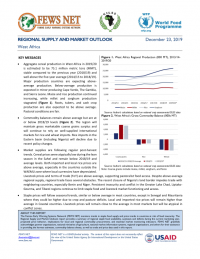Aggregate cereal production in West Africa in 2019/20 is estimated to be 75.1 million metric tons (MMT), stable compared to the previous year (2018/19) and well above the five-year average (2014/15 to 2018/19). Major production countries are expecting above- average production. Below-average production is expected in minor producing Cape Verde, The Gambia, and Sierra Leone. Maize and rice production continued increasing, while millet and sorghum production stagnated (Figure 1). Roots, tubers, and cash crop production are also expected to be above average. Pastoral conditions are fair.
• Commodity balances remain above average but are at or below 2018/19 levels (Figure 2). The region will maintain gross marketable coarse grains surplus and will continue to rely on well-supplied international markets for rice and wheat imports. Rice imports in the Eastern basin (including Nigeria) will decline due to recent policy changes
• Market supplies are following regular post-harvest trends. Cereal prices were atypically low during the lean season in the Sahel and remain below 2018/19 and average levels. Both imported and local rice prices are above average, especially in the countries outside the WAEMU zone where local currencies have depreciated.
Livestock prices and terms of trade (ToT) are above average, supporting pastoralist food access. Despite above-average regional supply, regional trade faces several obstacles. The recent closure of Nigeria’s land border impedes trade with neighboring countries, especially Benin and Niger. Persistent insecurity and conflict in the Greater Lake Chad, Liptako- Gourma, and Tibesti regions continue to limit staple food and livestock market functioning and access.
• Staple prices will follow seasonal trends, similar or below average in most countries, except in Senegal and Mauritania where they could be higher due to crop and pasture deficits. Local and imported rice prices will remain higher than average in Coastal countries. Livestock prices will remain close to the average in most markets but will be atypical in conflict zones.

